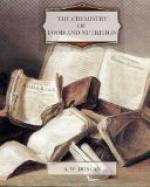composition of beef-tea closely resembles urine, and
is more an excrementitious substance than a food.
Those whose business it is to make a pure meat-broth,
for the purpose of preparing therefrom a nutrient for
experimenting with bacteria, cannot fail to recognise
its similarity both in odour and colour to urine.
Little consideration is needful to show the untruthfulness
and the absurdity of the statements made by manufacturers
as to the food value of these extracts. Fresh
lean beef contains about 25 per cent. of solid nutriment
and 75 per cent. of water. If lean beef be desiccated,
one pound will be reduced to four ounces of perfectly
dry substance; this will consist of about 80 per cent.
of proteid matter and nearly 20 per cent. of fat including
a little saline matter and the extractives. This
is as far as it is possible to concentrate the beef.
If it were possible to remove, without interfering
with the nutritious constituents, the membraneous
matter, the creatin, creatinine and purin bodies,
we should reduce it to a little less than four ounces.
It is very remarkable that the most nutritious matter
of the beef, the muscle substance or proteid and the
fat, are rejected in making Liebig’s extract,
whilst the effete or waste products are retained.
In Bovril and some other preparations, some meat fibre
has been added with the object of imparting a definite
food value. Hence in some advertisements, now
withdrawn, it was alleged that the preparations were
immensely superior in nutritive value to ordinary
meat extracts. The Bovril Company extensively
circulated the following:—“It is
hard for ladies to realise that the beef tea they make
at home from the choicest fresh beef contains absolutely
no nourishment and is nothing more than a slight stimulant.
It is so, however, and many a patient has been starved
on beef tea, whether made from fresh beef or from
the meat extracts that are sold to the public.
From these Bovril differs so much that one ounce of
its nutritious constituents contains more real and
direct nourishment than fifty ounces of ordinary meat
extract.” If analyses of meat extracts
are referred to, it will be seen that the principal
part of Bovril is the meat bases and other things common
to all such extracts, and which the Company in their
circular so emphatically condemn. If the meat
fibre, which is the principal, if not the sole difference,
is the only nourishing constituent, it is difficult
to see the advantage over ordinary beef, which can
be procured at a very small proportionate cost.
Concerning this added meat fibre, C.A. Mitchell,
in “Flesh Foods,” writes: “As
this amounts to at most some 8 or 10 per cent., it
is obvious that a large quantity of the substance would
be required to obtain as much unaltered proteid as
is contained in an egg. On the other hand, it
has been pointed out that there is nothing to show
that flesh powder suspended in meat extract is more
digestible than ordinary flesh in the same fine state




